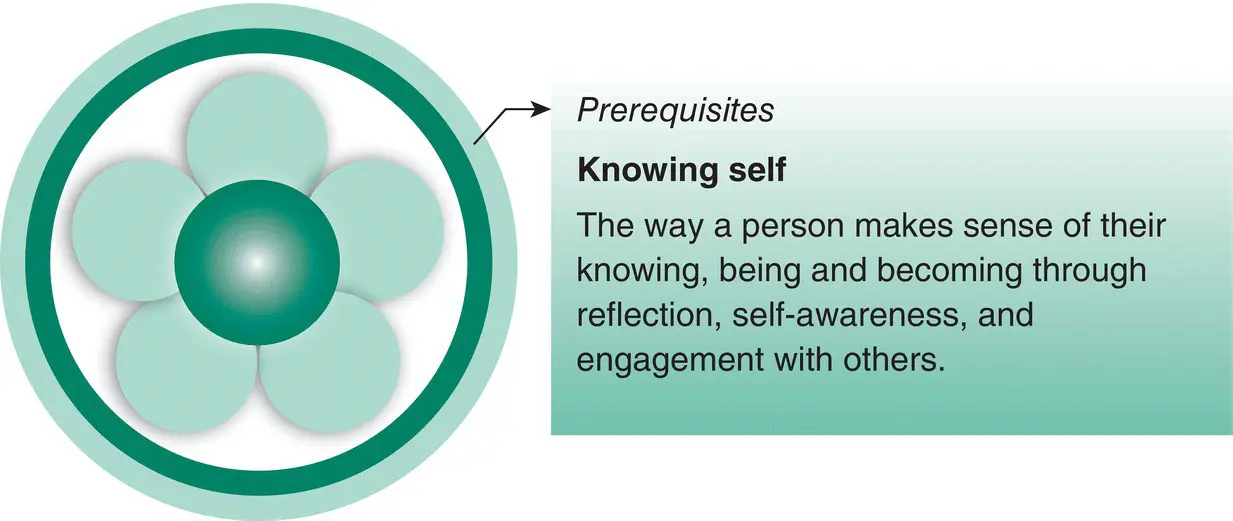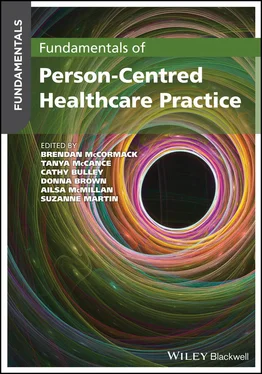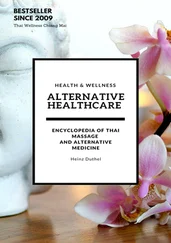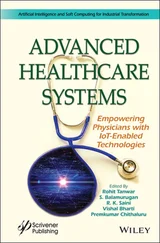The Person‐centred Practice Framework comprises four main domains: prerequisites, which focus on the attributes of staff; the practice environment, which focuses on the context in which care is delivered; the person‐centred processes, which focus on delivering care to people through a range of activities; and the outcome, which is the result of effective person‐centred practice.
The Person‐centred Practice Framework sits within the broader macro context (the fifth domain), reflecting factors that are strategic and political in nature that influence the development of person‐centred cultures.
The Person‐centred Practice Framework provides a language that enables people to name components of person‐centredness and barriers and enablers that influence its development in the workplace.
1 Buetow, S. (2016). Person‐Centred Health Care: Balancing the Welfare of Clinicians and Patients. London: Routledge.
2 Dewing, J. (2012). Bringing Merleau‐Ponty's inspirations to working with participants. In: Creative Spaces for Qualitative Researching, Living Research (eds. J. Higgs, A. Titchen, D. Horsfall and D. Bridges). Amsterdam: Sense Publications.
3 Fitzpatrick, J.J. and Whall, A.L. (2016). Conceptual Models of Nursing: Global Perspectives, 5e, 118–131. Boston, MA: Pearson.
4 McCance, T.V. (2003). Caring in nursing practice: the development of a conceptual framework. Research and Theory for Nursing Practice: An International Journal 17 (2): 101–116.
5 McCance, T.V., McKenna, H.P., and Boore, J.R.P. (1999). Caring: theoretical perspectives of relevance to nursing. Journal of Advanced Nursing 30 (6): 1388–1395.
6 McCormack, B. (2001a). Autonomy and the relationship between nurses and older people. Ageing and Society 21: 417–446.
7 McCormack, B. (2001b). Negotiating Partnerships with Older People – A Person‐Centred Approach. Basingstoke: Ashgate.
8 McCormack, B. and McCance, T. (2016). United Kingdom: the person‐centred nursing model. In: Conceptual Models of Nursing: Global Perspectives, 5e (eds. J.J. Fitzpatrick and A.L. Whall), 118–131. Boston, MA: Pearson.
9 McCormack, B. and McCance, T. (2017). Person‐Centred Practice in Nursing and Healthcare: Theory and Practice. Oxford: Wiley‐Blackwell.
10 McCormack, B., McCance, T., Slater, P. et al. (2008). Person‐centred outcomes and cultural change. In: International Practice Development in Nursing and Healthcare (eds. K. Manley, B. McCormack and V. Wilson), 189–214. Oxford: Blackwell.
11 McCormack, B., Dewing, J., and McCance, T. (2011). Developing person‐centred care: addressing contextual challenges through practice development. Online Journal of Issues in Nursing 16 (2): 3.
12 Mitchell, E., McCance, T., McCormack, B., and Gribben, B. (2015). Patients' experiences of in‐hospital care when nursing staff were engaged in a practice development programme to promote person‐centredness: a narrative analysis study. International Journal of Nursing Studies. 52: 1454–1462.
13 Peplau, H. (1997). Peplau's theory of interpersonal relations. Nursing Science Quarterly 10 (4): 162–167.
14 Roper, N., Logan, W., and Tierney, A. (2000). The Roper‐Logan‐Tierney Model of Nursing. London: Churchill Livingstone.
15 Rycroft‐Malone, J. (2004). PARIHS framework – a framework for guiding the implementation of evidence based practice. Journal of Nursing Care Quality 19 (4): 297–304.
16 Rycroft‐Malone, J., Seers, K., Chandler, J. et al. (2013). Role of evidence, context, and facilitation in an implementation trial: implications for the development of the PARIHS framework. Implementation Science 8 (28) article no. 28.
17 Seedhouse, D. (1986). Health: The Foundations for Achievement. London: Wiley.
18 Sharp, S., Mcallister, M., and Broadbent, M. (2018). The tension between person‐centred and task focused care in acute surgical setting: a crtical ethnography. Collegian 25: 11–17.
19 Watson, J. (1985). Nursing: Human Science and Human Care – A Theory of Nursing. New York: National League of Nursing Press.
20 Wolf, A., Moore, L., Lydahl, D. et al. (2017). The realities of partnership in person‐centred care: a qualitative interview study with patients and professionals. British Medical Journal Open 7: e016491.
21 World Health Organization (2001). International Classification of Functioning, Disability and Health (ICF). Geneva: World Health Organization.
22 Yuill, C., Crinson, I., and Duncan, E. (2010). Key Concepts in Health Studies. Sage Key Concepts. London: Sage.
1 Manley, K., Sanders, K., Cardiff, S., and Webster, J. (2011). Effective workplace culture: the attributes, enabling factors and consequences of a new concept. International Practice Development Journal 1 (2): 1–29.
2 McCance, T., Hastings, J., and Dowler, H. (2015). Evaluating the use of key performance indicators to evidence the patient experience. Journal of Clinical Nursing 24: 3084–3094.
3 Slater, P., McCance, T., and McCormack, B. (2017). The development and testing of the person‐centred practice inventory – staff (PCPI‐S). International Journal of Quality in Healthcare 29 (4): 541–547.
Donna Brown1 and Savina Tropea2
1 Ulster University, Northern Ireland, UK
2 Queen Margaret University, Edinburgh, Scotland, UK
Introduction
Understanding and defining self: different perspectives
Different aspects of self
The journey through ‘knowing self’: tools and approaches
The importance of self‐knowledge for developing healthful cultures
Using reflection to know self
Creating the conditions to know self and others
Conclusion
Summary
References
Gain some understanding of the different perspectives of self.
Determine how the choices we make impact upon our professional and personal self and vice versa.
Refine our personal self‐awareness

This chapter will primarily focus on the prerequisite of knowing self. It will also consider the importance of knowing self in relation to the care environment and to the person‐centred processes. We will explore the value of knowing self, as a person, and consider ways in which we can become more aware of self, of how this awareness impacts on working relationships between colleagues and the person using health services.
Understanding and defining self: different perspectives
In the Person‐centred Practice Framework, knowing self is defined as the way a person makes sense of their knowing, being and becoming through reflection, self‐awareness and engagement with others. This definition will guide our thinking as we work through this chapter. Within this perspective, self is not viewed as something fixed. As persons, we are on a constant journey of learning to ‘find and re‐fine oneself’ (Dworkin 1991, p. 32). With the goal of self‐development, we engage with lifelong learning and professional growth, through developing self‐awareness and engaging in self‐reflection.
Before exploring why it is important to know self and what the process of knowing self may look like, we need to develop an understanding of what self is. Throughout history, philosophers, psychologists, sociologists and social psychologists have formulated different definitions and theories of self which have resulted in conflicting perspectives about what self is, its nature and the method of investigation. We have here provided a brief summary of the key perspectives on self to encourage exploration of how these may relate to you and the person‐centred perspective. When consulting other texts, you might see slightly different terminology from the one used here.
Читать дальше













